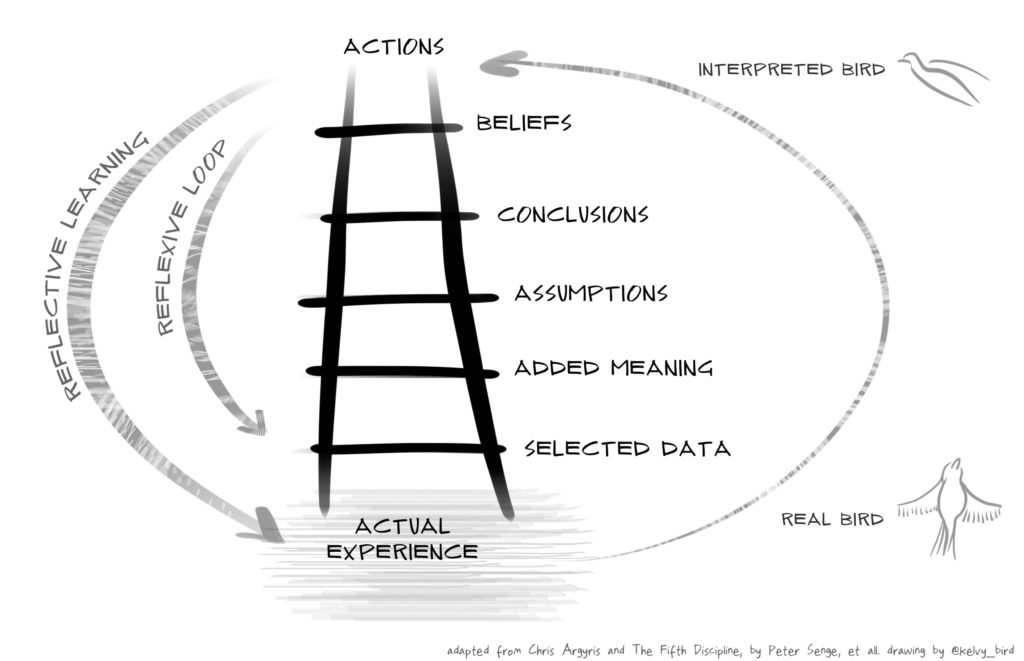A visual practitioner must continually orient their inner landscape and seek to SUSPEND beliefs and judgements that block clear listening and an Open Mind. This requires ongoing self check-ins and mental model alignment, as related to ourselves, the content, the people in the room, the organization(s), and even the sector or region of the world represented.
It is far too easy to get tripped up by our own way of thinking, and inadvertently close off to what is actually happening. A room of 50 men in blue suits does not necessarily indicate a group of businessmen – it could be a NY Yankees reunion! or, or, or….. There could be dozens of interpretations, depending on our background and sorting mechanisms.
One fundamental framework to keep in mind is Chris Argyris’ Ladder of Inference, which describes the scale of thinking between experience-based data and belief-based action. Though all steps exist in the “now”, the top of the ladder tends to waver more abstractly in memory, and the bottom lands more solidly in the present moment.
Here is a breakdown (with reference to Google definitions):
Beliefs: Acceptances that a statement is true or that something exists.
ie: For someone to recognize a bird, I need to represent it in flight
Conclusions: Judgment or decision reached by reasoning.
ie: Birds fly.
Assumptions: Things that are accepted as true or as certain to happen.
ie: Cardinals, and all birds for that matter, must fly around a lot.
Added Meaning: What is interpreted as meant by a word, text, concept, or action.
ie: Cardinals must travel to many backyards in a day for food.
Selected Data: Chosen facts and statistics collected for reference.
ie: Cardinals eat off flat surfaces and come and go freely.
Observable Data & Experience: Practical contact with facts or events or occurrences.
ie: Sometimes my brother and i watch cardinals feeding in his backyard.
Reflexive Loop: Confirms bias. Beliefs influence data we choose to select in the future.
ie: I draw birds in flight, and watch birds coming and going, but not birds on branches.
Reflective Learning: Looking more closely to increase our understanding.
ie: I have serious challenge drawing animals, but if i more closely observe real birds in a variety of settings and notice their range of forms, my drawing will improve.
A purely behavioral example, not applied to scribing, would be something like this – starting at the experience and jumping around, as it can happen in real life:
I call my mom and ask how she is doing. (Data) “Fine,” she answers. (Data)
But i think to myself, “Her voice is low and her words are slow. (Data) She does not SOUND fine…” (Added Meaning) “Uh-oh. This is going to be one of THOSE kinds of uncomfortable conversations, loaded with innuendo.” (Beliefs)
See how fast i made that jump?!?!
Then i ask,”Is something going on?” I’m trying to inquire to scale down back to data.
“No, i am getting ready for XX today and the plumber is coming and XX etc.” (lots of data)
But in my body, in my heart, I sense gaps in this data, and am hearing something else behind the words, in her tone, and still can’t help think there is something more going on. (Conclusion)
I am substituting my reality (Selected Data) for hers – and i’m getting fixated that i am right about my interpretation.
“My mother is hiding something. Maybe she is trying to protect me, or not bother me. And clearly she does not want to talk about it now! All she wants is banter; this will not be a substantive conversation. (Belief) I might as well get off the phone now. (Action)”
Again – see how quickly i scaled back up?! And, in doing so, got lost in my own story about the call, became reflexive, stopped listening to my mom, and prematurely ended the call.
Back to how this applies to scribing…
To inquire into the situation, in order to surface the data, requires “scaling down the ladder.” As graphic facilitators, we must always return to actual words, no matter our triggers or wishes for the outcomes of a session. If something is not clear, pause. Slow down. Wonder. Check the reasoning. Turn away from the board and mentally move closer to the words, to the person speaking, to the data. Put yourself in their shoes. Inhabit another vantage point. Resist the urge to draw until you return to ground.
This kind of real-time inquiry risks getting in the way of our needed liquid state; to be checking what we heard for accuracy can break the momentum of attending to the next words, and the next after those. But one spot-on interpretation against 100 misrepresented ideas in invaluable. A picture is only worth 1000 words if it lands in an array of reference.
In the domain of Perceiving, in A Practice Model for Scribing, the Ladder is key.
The Ladder of Inference was first put forward by Chris Argyris and expanded in Peter Senge’s The Fifth Discipline. For additional reading, see: The Ladder of Inference by Rick Ross, excerpt from The Fifth Discipline Fieldbook. Copyright 1994 by Peter M. Senge, Art Kleiner, Charlotte Roberts, Richard B. Ross, and Bryan J. Smith. Original illustration by Martie Holmer.
